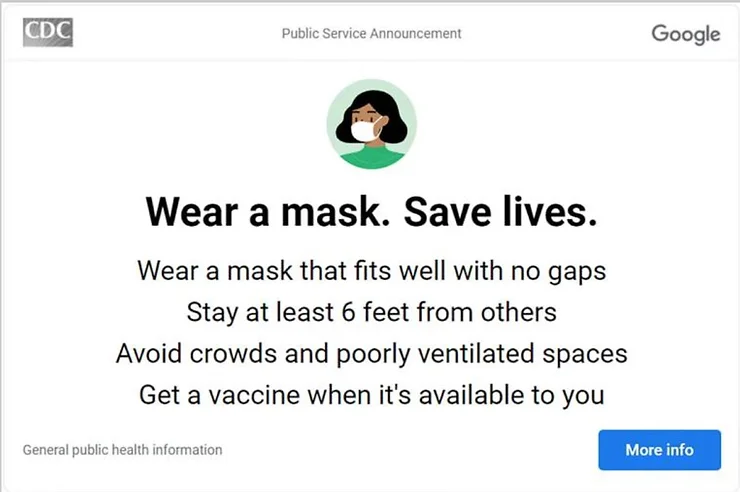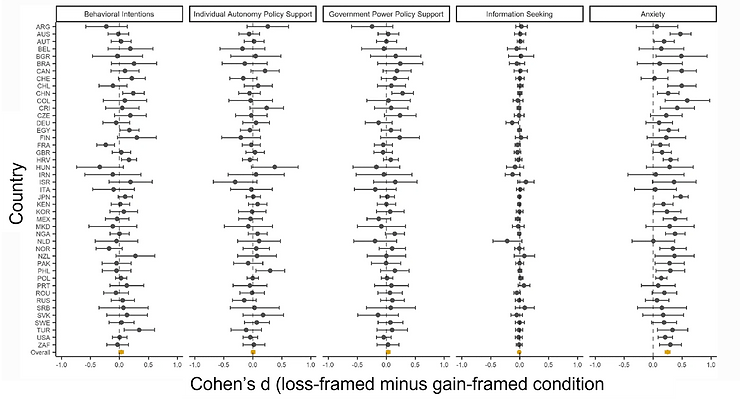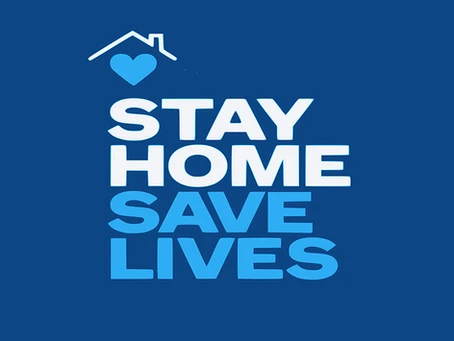Does “good vibes only” make for effective COVID-19 communication?
By Sarah Ferguson
Title: In COVID-19 Health Messaging, Loss Framing Increases Anxiety with Little-to-No Concomitant Benefits: Experimental Evidence from 84 Countries
Author(s) and Year: Charles A. Dorison & Jennifer S. Lerner & Blake H. Heller & Alexander J. Rothman & Ichiro I. Kawachi & Ke Wang, et al. 2022
Journal: Affective Science (open access)
TL;DR: Loss framing and gain framing produced similar effects on behavior during the COVID-19 pandemic, but loss framing increased audience’s anxiety significantly compared to gain framing.
Why I chose this paper: When you’re trying to get an audience to take something seriously, it can be very tempting to want to tell them how bad things could be. I chose this paper to learn if communicating losses was effective when dealing with severe consequences and how it impacts the audience.
Have you ever been tempted to motivate someone by telling them what they could lose if they didn’t listen? The 2021 movie, Don’t Look Up, illustrates this during a scene where a scientist trying to inform the public about an earth destroying comet screams into the camera “ …we’re all 100% going to f****** DIE!” While communicating about an earth destroying comet is not on the docket for most science communicators, risk management frequently is.
During the COVID-19 pandemic, science communicators grappled with informing the public about protective measures and the potential health impacts. Was it better to tell people what they could lose if they didn’t follow intervention guidance? Or was it better to tell people what they could gain by following intervention guidance? These two approaches are known as loss framing or gain framing. Loss framing emphasizes potential losses while gain framing emphasizes potential gains, but both can be used to influence behavior. A study borne out of the Psychological Science Accelerator (PSA) COVID-19 Rapid Project sought to measure the difference in benefit between loss and gain framing and if loss framing was worth the anxiety it might produce.
The Method
Dorison and colleagues’ experiment was part of the PSA COVID-19 Rapid project, a collection of three studies focused on understanding the psychological and behavioral features of the COVID-19 project in a global way. The purpose of the experiment was to understand the effects of loss and gain framing COVID-19 health messages on a global scale, as well as investigating the negative emotional effect that loss framing might have.
Research groups affiliated with the PSA or research panels recruited 15,929 participants from 84 countries between April and September of 2020. Participants first completed a pre-study questionnaire to gain information about their demographic and anxiety level about the COVID-19 pandemic before moving on to the experiment.
Participants in the experiment viewed identical COVID-19 health recommendations (e.g., staying home, wearing a face mask), with either a loss or gain framed message at the top of each page. Figure 1 shows an example of a gain framed message.
Loss Frame Message : “There is so much to lose. You can get sick and endanger the health of others if you do not practice these four steps.”
Gain Frame message: “There is so much to gain. Practicing these four steps can help you stay healthy and protect the health of others.”
The participants then completed a survey related to behavioral outcomes with the same loss or gain message they had viewed previously repeated at the beginning of their survey. Participants rated their likelihood to follow COVID-19 recommendations, their anxiety levels, and their interest in learning more about COVID-19.

The Results
Researchers found no difference in framing effect across the 84 countries. The version of the frame or loss message used also had no effect on survey outcomes.
There was also no major difference between loss and gain framing for behavioral outcomes or support of policy changes for COVID-19. Loss framing did decrease information seeking, but only by 4% or less.
However, loss framing increased anxiety in participants. Multiverse analysis of 162 ways to process and model the data showed that all models found significant increases in anxiety when loss framing was used. This effect was also not dependent on the levels of participants’ pre-study anxiety.
Figure 2 compared the effect of loss vs gain framing on behavior, policy support, information seeking and anxiety. Dots and bars to the right side of the dashed line for each variable show higher levels of the variable measured. Each dot and bar pair represents groups from a different country while the yellow dot closest to the x axis represents the effect across all countries. While there is no significant difference between loss and gain framing for behavior, policy support or information seeking, the effect on anxiety was significant. In the last column, all data points are to the right of the dashed line, indicating that loss framing produced higher levels of anxiety.

The Impact
The study found no difference in behavioral outcomes between loss and gain framing, but globally, participants reported increased anxiety when loss framing was used.
Though this study focused specifically on the COVID-19 pandemic, research on other topics with severe consequences has also found that paying attention to the emotion that framing elicits in an audience can help boost their support and advocacy for science related issues. For example, research on communicating climate change has shown that gain framing can increase hope and overall positive attitudes towards mitigation strategies, both of which increased support for advocacy.
Gain framing could be a better way to communicate risks and motivate audiences to take action in response to health or environmental crises as it has the same effect as loss framing, without causing excess anxiety.
Edited by Mahima Samraik and Niveen AbiGhannam
Cover image credit: Grégory Roose

